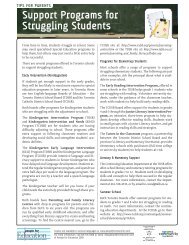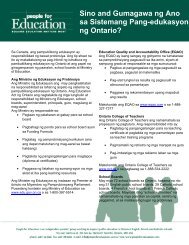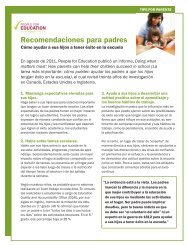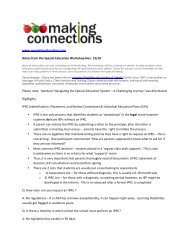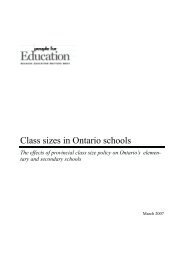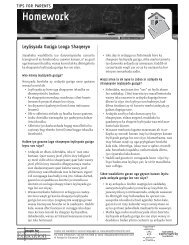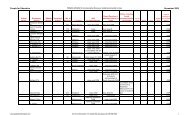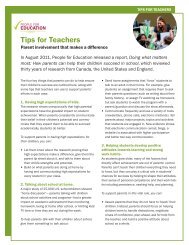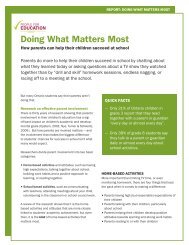Our Children Our Future Our Vision - People for Education
Our Children Our Future Our Vision - People for Education
Our Children Our Future Our Vision - People for Education
Create successful ePaper yourself
Turn your PDF publications into a flip-book with our unique Google optimized e-Paper software.
<strong>Our</strong> <strong>Children</strong>, <strong>Our</strong> <strong>Future</strong>, <strong>Our</strong> <strong>Vision</strong><br />
• Provincial jurisdiction impeding on First Nation jurisdiction;<br />
• Lack of adequate resources;<br />
• Federal control over First Nation education;<br />
• Policy assumption remains that we can’t take care of ourselves;<br />
• No recognition of the diversity of Indigenous Nations;<br />
• Local community members not empowered to understand and participate;<br />
• Capital funding, space requirements are inadequate and <strong>for</strong>ces service from provinces;<br />
• No funding <strong>for</strong> modernization or <strong>for</strong> multi-level learners;<br />
• Provinces profit off per capita tuition even when students leave. 175<br />
This list is just a sample of the many barriers that make significant progress in First Nation education<br />
more than just a challenge – it makes student success under these conditions nearly impossible.<br />
This seems to be the anti-thesis to some of the recommendations made by the Auditor<br />
General, RCAP and countless other federal studies, panels and commissions. All of these issues<br />
are well-known by First Nations, governments and policy makers. The key now will be to move<br />
from study to action.<br />
Canada must take real action on the recommendations of previous studies and honour Treaty,<br />
legal, and constitutional obligations to work with First Nations to address the funding barriers<br />
identified and ensure the education funding provided supports the holistic, lifelong learning needs<br />
of all levels First Nations education in Ontario.<br />
5. Moving Forward<br />
There can be no doubt that the current federal control over First Nations education must finally<br />
come to an end. Improvements can only truly be made with First Nation control over First Nation<br />
education. First Nation control affects everything from curriculum, pedagogy, data collection, and<br />
measurements of success. Even when we do control our own processes and show some success,<br />
it rarely gets reported. 176 Many mainstream reports overlook our unique social, political and<br />
economic realities. 177 Thus, our ef<strong>for</strong>ts don’t get counted in the range of possible solutions <strong>for</strong> moving<br />
<strong>for</strong>ward. Instead, federal bureaucrats in Ottawa come up with their own policy options which<br />
suit their needs and then present us with a limited menu from which to choose an option.<br />
The educational achievement gap is widening instead of closing and we know from the Auditor<br />
General’s reports that it may still take decades to catch up even if we act now. This is yet another<br />
reason why control over our own educational future is so very important.<br />
175 Assembly of First Nations, “Investing in the <strong>Future</strong>: First Nations <strong>Education</strong> in Canada”, (Ottawa: AFN, 2003) [Investing<br />
in the <strong>Future</strong>] at 13-18.<br />
176 Canadian Council on Learning, “Redefining How Success is Measured in First Nations, Inuit and Métis Learning<br />
Report” (Ottawa: CCL, 2007).<br />
177 Ibid.<br />
Chiefs of Ontario<br />
44



